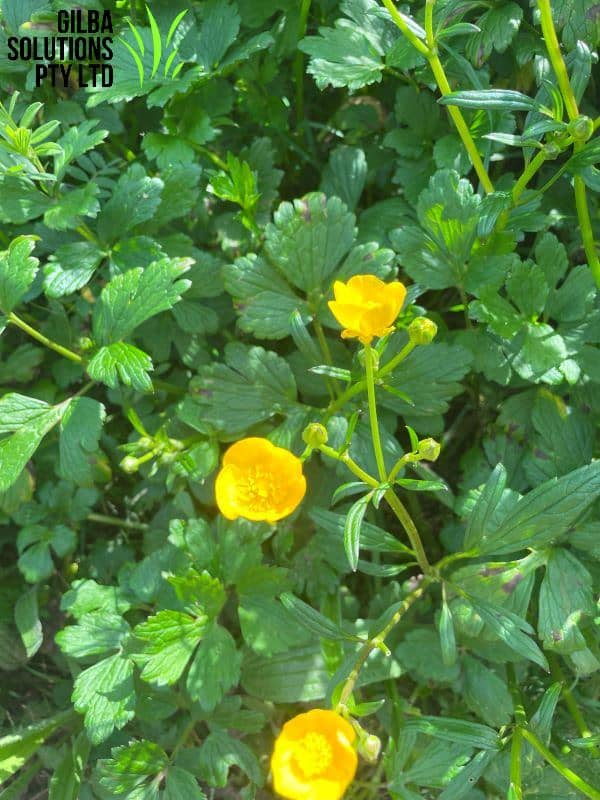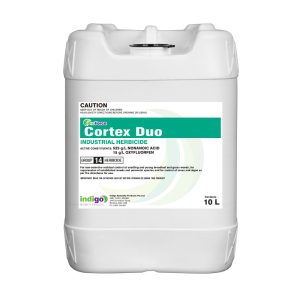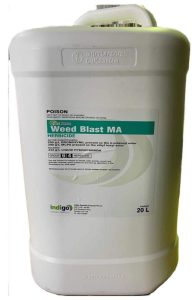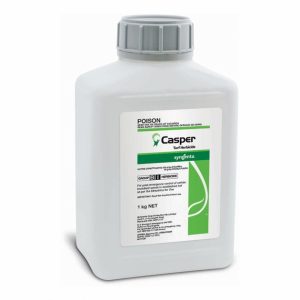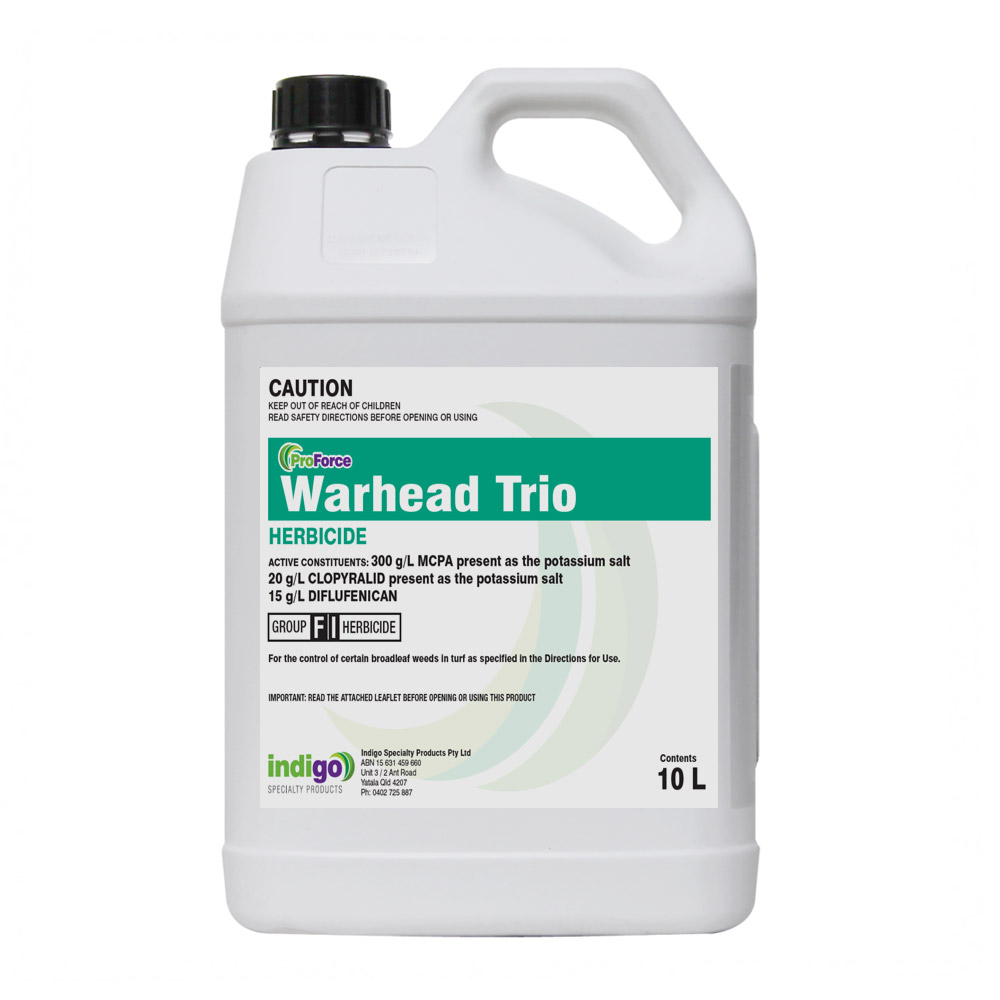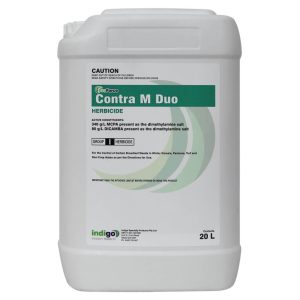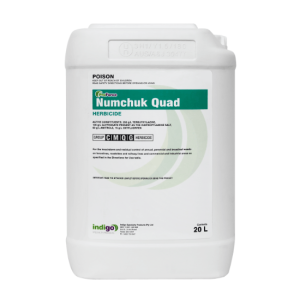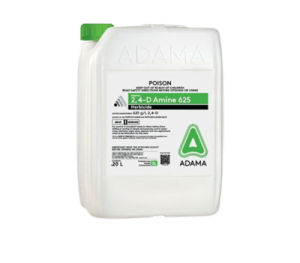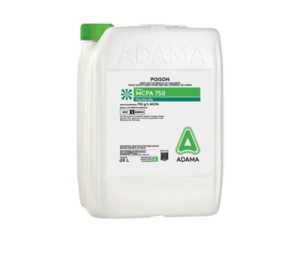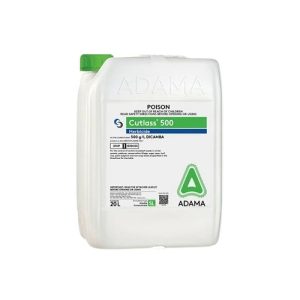Creeping Buttercup (Ranunculus repens).
Creeping Buttercup (Ranunculus repens) is a common perennial weed that you find in turf and lawns. It is particularly common in wet, poorly drained soil.
Ranunculus repens spreads rapidly (up to 4 m2 in a year) by stolons. Stolons are long runners at the soil surface that root at each node. It is a good indicator weed of poorly drained soils.
Ranunculus repens is a significant environmental weed in VIC, NSW and the ACT.
After you read this, you will be able to:
- Identify Creeping Buttercup.
- Know its habitat.
- Know the best ways to control Ranunculus repens.
Why is Creeping Buttercup a Problem Weed?
- This weed quickly crowds out native plants.
- It depletes Potassium in the soil.
- It reduces pasture productivity.
- Ranunculus repens impedes water flow in drains.
- It is toxic to stock.
Creeping Buttercup is poisonous, and contains a compound called ranunculin. When you crush or bruise the leaves, ranunculin breaks down to form an acrid, toxic oil that causes dermatitis.
You see the effects of this within an hour of contact with Ranunculus repens. The symptoms include burning and itching as well as rashes and blisters.
If you chew the leaves, blisters form on the lips and face. If you swallow it, severe stomach irritation follows, along with dizziness, spasms, and paralysis. The toxic oil is also an eye irritant.
The distribution map for Ranunculus repens is courtesy of The Atlas of Living Australia.
Key Takeaways.
- Creeping Buttercup is poisonous.
- It spreads by seed and stolons.
- It indicates poor soil drainage.
- You need both cultural and chemical means to control Ranunculus repens.
- You get the best results with 2 or 3-way mixes that contain 2,4-D, MCPA, and Dicamba.
How to Identify Creeping Buttercup.
New plants form a rosette of leaves and stems, and some stems act as stolons. The stolons grow along the soil surface. These stolons produce shoots and root at the nodes.
Category: It is a Broadleaf (Dicot) weed.
Photosynthetic Pathway: It is a C3 Weed.
Flower: Ranunculus repens has shiny yellow flowers with five overlapping petals, that are 2 to 3 cm in diameter. You see the flowers over the Spring and Summer.
Height: Plants can be up to 50 cm tall.
Leaf length: The dark green compound, basal leaves Ranunculus repens are on a 4 to 20 cm long petiole. This divides into three broad leaflets 1.5 to 8 cm long, that are shallow to deeply lobed, and on stalks.
As you move up the stem the leaves become smaller, with narrow leaflets. These may be simple or lance shaped.
Reproduction: Ranunculus repens spreads by seeds and hairy, creeping stolons. Once a new plant develops vegetatively the stolon dies, which allows it to grow independently.
Individual plants rarely survive longer than about 18 months. By this stage each plant will have produced several new daughter plants.
The seeds disperse in water or by animals.
Comments: Both the stems and the leaves have a cover of fine hairs.
Habitat: Ranunculus repens is often found in poorly drained, wet soils, and sunny or shaded areas. It favours disturbed and nutrient rich soils.
For more information on weeds check out our weed ID Chart.
How to Control Creeping Buttercup.
You can control Creeping Buttercup by cultural and chemical means, but the best way to manage this weed is if you adopt an integrated approach. Autumn is the perfect time carry out control of this perennial weed.
Management Calendar for Creeping Buttercup.
Management Calendar for Creeping buttercup | ||||||||||||
Perennial | ||||||||||||
Month | Jan | Feb | Mar | Apr | May | Jun | Jul | Aug | Sep | Oct | Nov | Dec |
Germination | ||||||||||||
Active Growth | ||||||||||||
Flowering/Seeding | ||||||||||||
Pre Emergent Herbicide | ||||||||||||
Post Emergent Herbicide | ||||||||||||
Mechanically remove, and slash plants | ||||||||||||
Cultural Control of Creeping Buttercup:
- This is a shallow-rooted weed. This means that you can dig it up by hand. However, you must make sure that you remove all the root and stem fragments.
- It is easier to remove this weed over the Autumn and the Spring when the soil is moist.
- If you improve the turf density it reduces infestations.
- Fertilize properly.
- Mow at the right height. This weed tolerates being closely mown because the stolons tend to grow very close to the ground. However, although mowing does not directly control it, if you rake before you mow it lifts the stolons and prostrate stems.
- Improve the drainage, and do not over water.
- Use turf grasses that are adapted to the site conditions.
Chemical Control of Creeping Buttercup.
- Treat Ranunculus repens when it is actively growing from the Spring to the Autumn.
- Herbicide treatments are less effective if the plants are under drought stress.
- Be aware that even when you treat this weed with a herbicide, it will tend to regrow. This means that you must be ready re-treat if you see any signs of regrowth.
Post Emergent Control of Creeping Buttercup.
You can control or suppress this weed with post emergent herbicides.
Post emergent options should contain combinations of 2,4-D, MCPA, Prosulfuron and Dicamba. Suitable options include:
- Casper Turf Herbicide. Do not use on Buffalo grass.
- ProForce Warhead.
- ProForce Weed Blast MA
- Dicamba. Do not use on Buffalo grass. and
- Contra M. Do not use on Buffalo grass.
Table of Post Emergent Herbicide Rates for Creeping Buttercup.
Product | Active | Chemical Group | Rate/Ha | Comments | ||||
2,4-D | 2,4-D | 4 | 1.8-3.2 | Wet foliage. DO NOT mow lawn for 1 week before and at least 1 weed after use. DO NOT use on Buffalo grass (WA only). | ||||
Casper | Prosulfuron + Dicamba | 2 and 4 | 800g-1Kg | Apply from Autumn to Spring. Use high rates in cool months or if high weed pressure. Control takes 4 to 6 weeks. Use an NIS at a rate of 0.25 to 0.5% v/v. | ||||
Contra M. | Dicamba + MCPA | 4 | 6.5 L | Apply in 250-400L water. DO NOT use on Buffalo grass. Do not mow for 2 days before or after use or fertilize within two weeks. | ||||
Dicamba | Dicamba | 4 | 1.2L + 3.2L of 2,4-D Amine 625g/L | Use a minimum of 1000L/Ha water. Do not spray on Buffalo or Bent Grass. | ||||
MCPA | MCPA | 4 | 930ml -1.8L | Apply in high volume to actively growing weeds. DO NOT mow for 2 days before use. Some transitory damage may occur to fine turf grasses | ||||
Warhead | MCPA + Clopyralid + Diflufenican | 4 + 12 | 5 L | You may see discolouration on kikuyu, carpet grass and Queensland blue. Avoid overlapping. Use an NIS. | ||||
Weed Blast MA | Bromoxynil + MCPA | 6 + 4 | 3-6L | Apply in a minimum of 500L/Ha water. DO NOT mow for 2 days after treatment. | ||||
Non Selective Control of Creeping Buttercup.
Do not use any of these on lawns or turf areas to selectively remove this weed.
- Glufosinate-ammonium provides control for 4 to 6 weeks. However, once treated it tends to regrow due to the limited movement of glufosinate.
- Glyphosate. You can use Glyphosate but if water quality is an issue then use ProForce Manta Ray.
These are non-selective but also have a long term residual and stop any re-growth of Ranunculus repens.
- Renegade. Renegade stops germination for up to 12 months. This reduces the need for multiple herbicide applications.
- Numchuk Quad. This gives post and pre emergent control for up to 12 months.
- Cortex Duo. Cortex Duo gives a rapid knockdown and residual control for up to 3 months. It is also safe to use around trees.
Table of Non Selective Herbicides for Creeping Buttercup Management.
Product | Active | Chemical Group | Rate/Ha |
Glufosinate 200 | Glufosinate-ammonium | 10 | 1-6L |
Rapid Fire 800 | Glyphosate | 9 | 0.9-1.35 Kg |
Numchuk Quad | Terbuthylazine + Glyphosate + Amitrole Oxyfluorfen | 5 + 9 + 34 + 14 | 20-25L |
Cortex Duo | Nonanoic Acid + Oxyfluorfen | 14 | 7L/1000L |
Renegade | Bromacil | 5 | 3.5-6.5Kg |





